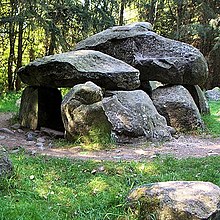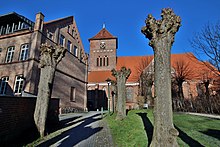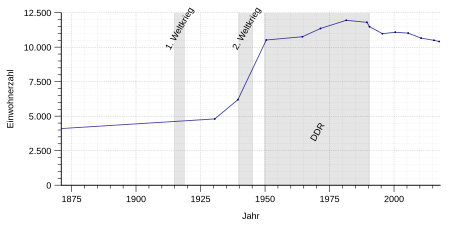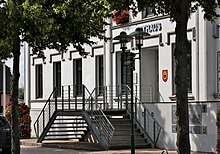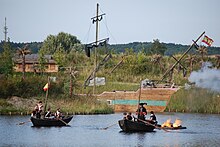Grevesmühlen
| coat of arms | Germany map | |
|---|---|---|

|
Coordinates: 53 ° 52 ' N , 11 ° 11' E |
|
| Basic data | ||
| State : | Mecklenburg-Western Pomerania | |
| County : | Northwest Mecklenburg | |
| Height : | 40 m above sea level NHN | |
| Area : | 52.33 km 2 | |
| Residents: | 10,434 (Dec. 31, 2019) | |
| Population density : | 199 inhabitants per km 2 | |
| Postal code : | 23936 | |
| Area code : | 03881 | |
| License plate : | NWM, GDB, GVM, WIS | |
| Community key : | 13 0 74 026 | |
| LOCODE : | DE GVY | |
City administration address : |
Rathausplatz 1 23936 Grevesmühlen |
|
| Website : | ||
| Mayor : | Lars Prahler (independent) | |
| Location of the city of Grevesmühlen in the district of Northwest Mecklenburg | ||
Grevesmühlen (also colloquially: Kreihnsdorp or Grevsmöhlen ) is a town in the district of Northwest Mecklenburg in the state of Mecklenburg-Western Pomerania . It is one of the 18 medium-sized centers in the state and part of the Hamburg metropolitan region . Grevesmühlen is the seat of the administrative community that forms the city of Grevesmühlen with the Grevesmühlen-Land office .
geography
Geographical location
About 15 kilometers north of the city is the Baltic Sea , about 40 kilometers to the west is Lübeck, and 20 kilometers to the east is the Hanseatic city of Wismar . The urban area closes to the north with the Steinbrink forest area and the Santower See , to the west with the Grenzhausen and Börzower Wald districts, to the south with the hills of the Upahler Lehmberge and the Stepenitz , and to the east with the districts of Barendorf and Hoikendorf. The city and districts are surrounded by various forest areas as well as agricultural areas and are located in typical Mecklenburg hills and lakes. The Vielbecker See and the Ploggensee are in the immediate vicinity of the historic city center. The Santower See, the Everstorfer Forest and the Kalkflachmoor near Degtow are nature reserves.
City structure
The following districts belong to Grevesmühlen:
|
|
|
|
history
Surname
The original name of the town from 1226/1230 Gnewesmulne (Mill of Gnev) changed in 1237 to Gnewismulne , 1272 to Gnewesmolen and 1362 to Greuesmolen (n becomes r). The old Polish syllable Gnĕv could possibly be translated as “anger”. This syllable was supplemented by the Middle Low German syllable Molne for mill . Until the time before the First World War, the name Grevismühlen was also in use. The place is also often written in this way in Grevesmühlen church registers and the seal of the Nikolaikirche.
archeology
In today's district of Barendorf there are seven megalithic systems , including the passage grave of Jamel ; otherwise mostly restored ancient dolmen .
middle Ages
Grevesmühlen is one of the oldest cities in Mecklenburg. Gnevesmulne was first mentioned in 1226 and in 1262 as an oppidum (city). The village was already established during the Slavic settlement period. German colonists expanded the Slavic village into a city. The church was mentioned in 1230 in the Ratzeburg tithe register in the diocese of Ratzeburg . In addition to the castle on the market square mentioned in 1279 and the castle mentioned for the first time in 1345, which was not rebuilt after the great fire on June 15, 1659, which destroyed almost the entire city, the city had the right to mint coins from 1525 to 1567. Grevesmühlen was a country town represented in Mecklenburg and until 1918 as part of the cities of the Mecklenburg District on state parliaments.
The medieval city fortifications (13th century) with wall, Wiek houses , three city gates (water gate and the double gates Wismarsches and Lübsches Tor, 18th - 19th century), outer moat and rampart were demolished at the beginning of the 19th century, but are still in the city plan readable. The castle and the large city fortifications are evidence of the importance of the city at this time.
16th to 19th century
The city fires of 1725 and 1756 and the Seven Years' War did not allow the city to expand until around 1800. A brick factory was built in 1850, the malt factory in 1878 (since its renovation in 2004 a location of the district administration ), a dairy in 1890 and a sawmill in 1898. In 1877, the Jews living in the city laid a cemetery on Vielbecker Weg, which was no longer used in the 1930s, after the textile merchant Max Salomon was the last Jewish family to emigrate.
Recent history
On July 1, 1950, the previously independent communities Questin and Santow were incorporated. The Ploggenseering housing estate with around 600 apartments was built between 1965 and 1975. In the 1970s, the entire city center was to be replaced by new buildings. After the political change, the historic city center with its town hall was fundamentally renovated from 1991 as part of urban development funding.
From 1952 to 1994 Grevesmühlen was the district town of the Grevesmühlen district (until 1990 in the GDR - Rostock district , then in the state of Mecklenburg-Western Pomerania). In 1994, through a district reform, the district of Northwest Mecklenburg was created with Grevesmühlen as the district town. Grevesmühlen lost the district seat to the previously independent city of Wismar in the course of the district reform on September 4, 2011 , but is still the seat of the majority of the district administration.
Population development
|
|
|
politics
City council
The elections for the city council on May 26, 2019 led to the following result:
| Party / list | Share of votes * | Seats | +/- |
|---|---|---|---|
| CDU | 33.7% | 8th | −1 |
| SPD | 31.3% | 8th | +1 |
| The left | 21.2% | 5 | ± 0 |
| Voting community "grevesmühlen.jetzt" | 11.1% | 3 | ± 0 |
| Free Democratic Party (FDP) | 2.6% | 1 | + 1 |
| total | 100% | 25th |
+/−: Change compared to the 2014 election
The CDU and FDP have formed a joint parliamentary group with 9 members.
mayor
- 2001–2016: Jürgen Ditz (independent)
- since 2016: Lars Prahler (independent)
Prahler was elected in the mayoral election on September 18, 2016 with 50.4 percent of the valid votes for a term of eight years.
coat of arms
|
Blazon : "In red a four-spoke, toothed golden mill wheel, the spokes covered with a looking, golden crowned black bull's head with a torn red mouth, silver teeth, a knocked out red tongue, neck fur torn off in seven points and silver horns."
The coat of arms was redesigned and established in October 1897, redrawn in 1996 and registered under number 77 of the coat of arms of the state of Mecklenburg-Western Pomerania. |
|
| Justification of the coat of arms: The coat of arms, which has been in force since 1897 and is based on the seal image of the oldest city seal - first handed down as an imprint in fragments in 1276 - combines a symbol of power and a speaking symbol. The bull's head, which is typical of the Mecklenburg line of the Princely House, refers to the Lord of Mecklenburg as the founder and lord of the city. With the mill wheel the visual reference is made to the German part of the Slavic-German mixed name of the city, which is made up of the Slavic personal name Gnev and the German word molne (= mill). |
- Historical city arms
|
Blazon : “Split; in front in gold a half-looking, gold-crowned black bull's head at the crack with a torn red mouth, silver teeth, a knocked out red tongue, torn neck fur and silver horns; behind in red half a four-spoke, toothed golden mill wheel at the gap. "
The coat of arms was established on April 10, 1858 by Grand Duke Friedrich Franz II of Mecklenburg-Schwerin . |
|
| Establishment of the coat of arms: Before 1897, Grevesmühlen introduced a coat of arms based on the SECRETVM CIVITATVM DE GREWESMOLEN - first handed down as an imprint in 1350 - that has been verifiable at the town hall entrance since 1585 and was established in April 1858. |
flag
The flag was designed by the Schwerin heraldist Karl-Heinz Steinbruch and approved by the Ministry of the Interior on June 5, 2014.
The flag is evenly striped lengthways with red, yellow and red. In the middle of the flag, each half of the height of the red stripes, is the city coat of arms, lined with yellow. The relation of the height of the flag cloth to the length is like 3: 5.
Official seal
The city of Grevesmühlen has its coat of arms on a large official seal with a diameter of 3.5 cm with the inscription "STADT GREVESMÜHLEN • LANDKREIS NORDWESTMECKLENBURG" and on a small official seal with a diameter of 2.0 cm with the inscription "STADT GREVESMÜHLEN".
Town twinning
There has been a twinning with the city of Ahrensbök in Schleswig-Holstein since 1992 and with the Swedish municipality of Laxå since 2004 . In 2014 a partner agreement was signed with the Hungarian city of Nagymaros .
Sights and culture
Buildings
- Early Gothic town church St. Nikolai from the 13th century, three-aisled hall church in brick with accessible tower
- Half-timbered houses from the 18th and 19th centuries such as the Markt-Apotheke (around 1800), the "oldest house" in Große Seestrasse 1 (1660), residential houses at August-Bebel-Strasse 21, Große Alleestrasse 10, as well as in Hinterstrasse and Schulstrasse
- Wilhelminian style building : Post office in August-Bebel-Straße, warehouse in Mönchhof (late 19th century), school in Kleine Alleestraße (1899), building of the former malt factory (1893–1898)
- Former administrative building on the site of the former palace, originally a “princely house” from 1786 to 1790, from 1821 to 1928 administrative house , 1928 to 1952 town hall, 1952–1995 police house, demolished and reconstructed in 1965, complete renovation from 1995 to 1997, today the seat of the city administration and library
- The current headquarters of the ARGE Nordwestmecklenburg, Goethestrasse 1, created in 1921 based on plans by Karl Krämer; formerly the domain office , then the tax office, then the police station, then the headquarters of the Red Army and extensively modernized by 1994
- Museum and club house on Kirchplatz, received the special award for urban redevelopment in 2006 as part of the state building award due to the successful combination of old and new buildings
- Station reception building, built in 1873, extensively modernized in 2017
- Catholic Niels Stensen Church , established in 1989/91
- Grevesmühlen transmitter , basic network transmitter for VHF radio in Grevesmühlen-Hamberge
- Grevesmühlen windmill from 1878, the town's landmark, now used as an apartment
- The water tower, built in 1911, served the city's central water supply until 1967
Monuments and sculptures
- Medieval memorial stone by Ludeke Mozelleburch , a so-called Mordwange
- Sculptures Der Rufer , Lukullischer Traum , Kreihnsdorp , Elephant
- Cap Arcona memorial / cemetery from 1957 in the forest on the Tannenberg , near Tannenbergstrasse 27. 407 from Groß Schwansee rest in the cemetery , out of a total of 7,000 victims of the concentration camp ship “Cap Arcona”. In 2019 the memorial was restored, new access roads added and the content reorganized.
- Riflemen's guild stone from 1992 on the green spaces in front of the train station for the "victims of wars and injustice afterwards"
- Memorial stone from 1948 on the Jewish cemetery , artistically designed as a memorial with a Star of David since 1966
Regular events
Every year in mid-June the Grevesmühlen city festival takes place with the largest regular street parade in Mecklenburg-Western Pomerania, with a stage program and u. a. a city run and a sports afternoon. The city festival is mostly organized on a voluntary basis.
Every year in June the so-called Aluman is organized by those interested in sports, a triathlon for adults and children.
The Pirate Open Air has been held every year from the end of June to the beginning of September since 2005 . The event has so far been attended by around 60,000 spectators.
Every evening before Reformation Day there is the Grevesmühlen Culture Night with stage programs, a satirical play, light installations and readings at various locations. Music nights are organized twice a year.
The Kreihnsdkörper Advent market takes place on the 1st weekend in Advent. The event is organized jointly by the parishes of the city and the Grevesmühlen trade association.
Economy and Infrastructure
economy
In April 2019 the unemployment rate was 4.5% - the lowest in Mecklenburg-Western Pomerania.
The city is characterized by small businesses. Craft businesses, building trades, retail trade, services and administrative services make up the bulk of the added value. In terms of tourism, retailers and restaurants benefit from the proximity of the Baltic Sea and the Piraten Openair. The largest local employers are the district administration, the hospital, a cleaning company, a disposal company and care facilities.
In 2019, the city was selected by the Federal Ministry of the Interior, for Building and Home Affairs as one of 13 Smart Cities model projects.
traffic
Grevesmühlen is on the B 105 federal road between Dassow and Wismar and on the L 03 state road between Boltenhagen and Schwerin . The closest motorway junction is Grevesmühlen on the A 20 ( Lübeck - Rostock ).
Grevesmühlen station is on the Lübeck – Bad Kleinen railway line and is served every hour by the RE 4 regional express line ( Lübeck - Szczecin ). The Grevesmühlen – Klütz railway line began in Grevesmühlen, and passenger traffic was discontinued in 1995. From 1997 to 2005 there was tourist traffic with historic locomotives and railcars on the route.
Regular bus connections exist primarily to Lübeck (via Dassow), Wismar , the state capital Schwerin and the Baltic seaside resort Boltenhagen . In addition, all connections to the surrounding area from the bus station are operated by the local transport company "Nahbus". The city bus in Grevesmühlen runs during the day in regular service and as a dial- a- bus on individual order between 71 stops.
education
Grevesmühlen has the following schools:
- Gymnasium on the Tannenberg
- Regional school at the water tower
- Two primary schools (Am Ploggensee, Fritz Reuter)
- Two music schools (music school Fröhlich (owner Silvio Bollmann), district music school Carl Orff)
- Two special schools (general special school, school for individual coping with life)
Other facilities
Grevesmühlen was the seat of a local court . This was converted into a branch of the Wismar District Court in July 2015 .
The association Stadt ohne WATT has been campaigning for energy transition projects since 2003 . Supported by the city, the municipal utilities, the special purpose association and housing association as well as numerous association members, numerous individual projects have been implemented since then. All private households are supplied with electricity from renewable energy sources. District heating supplies around half of households and almost all public properties. The Grevesmühlen sewage treatment plant is the first energy + sewage treatment plant in Germany (2001).
Personalities
sons and daughters of the town
- August Pelzer , merchant and benefactor of the city, founder a. a. des Pelzer-Hains, secret councilor and honorary citizen of the city, co-founder of the Beautification Association and the Mecklenburg Trade Association (forerunner of the Rostock Chamber of Commerce)
- Paul Tarnow (1562–1633), Lutheran theologian and rector of the University of Rostock
- Joachim Drenckhan , (around 1570–1616), educator and rector in Stralsund
- Johann Tarnow (1586–1629), Evangelical Lutheran theologian and university professor
- Daniel von Plessen (1606–1672), administrative officer and district administrator of Mecklenburg, born in Hoikendorf
- Johann Joachim Kosegarten (1751–1825), pastor and author
- Ludwig Gotthard Kosegarten (1758–1818), pastor, professor and poet
- Heinrich Scharff (1803–1877), Evangelical Lutheran theologian and parliamentarian
- Luise Reuter (1817–1894), wife of the Low German writer Fritz Reuter
- Carl Balck (1831–1920), administrative lawyer and historian
- Wilhelm Neumann (1849–1919), architect and art historian
- Hedwig Wigger (1853–1918), novelist, translator and literary critic
- Karl Seß (1855–1939), politician and member of the Hamburg Parliament (SPD, USPD, KPD)
- Rudolph Karstadt (1856–1944), founder of the department store company of the same name
- Felix Bölte (1863–1943), philologist and high school teacher
- Heinrich Stubbe (1864–1941), Hamburg parliamentarian and senator (SPD), member of the Reichstag
- Wilhelm Krüger (1898–1977), veterinarian and university professor
- Gerd Tolzien (1902–1992), writer and journalist
- Klaus Grehn (1940–2017), politician (PDS), co-founder and president of the Unemployment Association Germany
- Jörg-Peter Findeisen (* 1943), historian
- Hans-Dieter Wallschläger (* 1947), biologist and genealogist
- Regine Marquardt (1949-2016), theologian and politician (SPD)
- Waldemar Büttner (* 1951), politician (CDU)
- Jörg Hacker (* 1952), biologist
- Manfred W. Jürgens (* 1956), painter and photographer
- Angelika Gramkow (* 1958), politician (Die Linke) and Lord Mayor of Schwerin
- Steffen Moratz (* 1967), radio play director and dramaturge
- Katrin Möller (* 1967), politician (Die Linke)
- Kai Grehn (* 1969), radio play director and author
- Monty Skull (* 1969), politician (non-party)
- Katrin Schröder (* 1975), biologist and physiologist
including athletes
- Hans Levknecht (1933–2015), football player and coach
- Heide Orth (* 1942), tennis player
- Hans-Dieter Jancker (* 1952), marathon runner
- Wolfgang Warnemünde (* 1953), track and field athlete
- Olaf Koschnitzke (* 1966), wrestler
- Timo Lange (* 1968), soccer player
- Astrid Kumbernuss (* 1970), shot put
- Jens Voigt (* 1971), racing cyclist
- Carsten Jancker (* 1974), soccer player
- Stefan Kupfernagel (* 1977), racing cyclist
- Johannes Brinkies (* 1993), soccer player
Trivia
In the novel, anniversaries of Uwe Johnson , the city hides behind the name Gneetz (apparently as a contrast to the neighboring town of Klutz , which stands in the center of the novel, but when Jerichow is named).
literature
- Friedrich Schlie : The art and history monuments of the Grand Duchy of Mecklenburg-Schwerin. Volume II: The district court districts of Wismar, Grevesmühlen, Rehna, Gadebusch and Schwerin. Schwerin 1898. (Reprint: Schwerin 1992, ISBN 3-910179-06-1 , pp. 339–351)
- Eckart Redersborg: The streets and squares of the city of Grevesmühlen. Self-published, Grevesmühlen 2001, ISBN 3-9807808-0-5 .
- Eckart Redersborg: Grevesmühlen in old views. European Library, Zaltbommeln NL 1991, ISBN 90-288-5252-2 .
- Author community: Grevesmühlen: urban renewal and development. City of Grevesmühlen and GOS redevelopment agency , 1998.
- Heidelore Böcker : Why, how and when did Grevesmühlen become a city? Image attachment by Alexander Rehwaldt. (= History and stories from the Grevesmühlen city archive. Issue 1). City archive Grevesmühlen, Grevesmühlen 2012, ISBN 978-3-9814380-4-8 .
Web links
- Literature about Grevesmühlen in the state bibliography MV
- Homepage of the administrative association Grevesmühlen
Individual evidence
- ↑ Statistisches Amt MV - population status of the districts, offices and municipalities 2019 (XLS file) (official population figures in the update of the 2011 census) ( help ).
- ↑ § 1 of the main statute of the city of Grevesmühlen
- ↑ Ernst Eichler , Werner Mühlmer: The names of cities in Mecklenburg-Vorpommern. Ingo Koch Verlag, Rostock 2002, ISBN 3-935319-23-1 .
- ↑ Ewald Schuldt : The Mecklenburg megalithic tombs. German Science Publishing House, Berlin 1972.
- ↑ Michael Prochnow: Discovered: GDR planners wanted to tear down the inner city. In: Ostsee-Zeitung . December 22, 2014, accessed August 11, 2016 .
- ^ Result of the election of the city council on May 26, 2019
- ↑ § 9 of the main statute of the city of Grevesmühlen
- ↑ Lars Prahler wins mayor election. In: Schweriner Volkszeitung , September 18, 2016.
- ↑ a b Hans-Heinz Schütt: On shield and flag - the coats of arms and flags of the state of Mecklenburg-Western Pomerania and its municipalities . Ed .: production office TINUS, Schwerin. 2011, ISBN 978-3-9814380-0-0 , pp. 164/165 .
- ↑ a b main statute § 2 (PDF).
- ↑ town twinning. In: grevesmuehlen.eu. Retrieved February 14, 2019 .
- ↑ Documentation of the memorials to the disaster at Cap Arcona. In: Gedenkstättenrundbrief 137, pp. 3–13, accessed on May 13, 2013.
- ↑ The unemployment rate is heading for a record low in Grevesmühlen. In: Ostsee-Zeitung. April 30, 2019, accessed August 5, 2019 .



